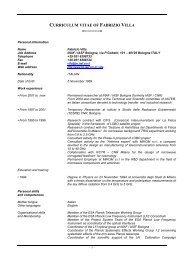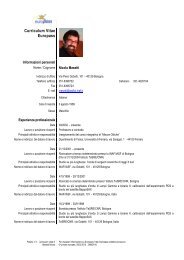booklet format - inaf iasf bologna
booklet format - inaf iasf bologna
booklet format - inaf iasf bologna
You also want an ePaper? Increase the reach of your titles
YUMPU automatically turns print PDFs into web optimized ePapers that Google loves.
Temporal Data Analysis A.A. 2011/2012<br />
Please note that |F (ω)| is no Lorentzian! If you want to “stick” to this property, you better represent<br />
the square of the magnitude: |F (ω)| 2 = 1/(λ 2 +ω 2 ), that is a Lorentzian. This representation<br />
is often also called the power representation: |F (ω)| 2 = (real part) 2 +(imaginary part) 2 . The phase<br />
goes to 0 at the maximum of |F (ω)|, i.e. when “in resonance”.<br />
Warning: The representation of the magnitude as well as of the squared magnitude does away<br />
with the linearity of the Fourier trans<strong>format</strong>ion!<br />
Finally, let us try out the inverse trans<strong>format</strong>ion and find out how we return to the “unilateral”<br />
exponential function (the Fourier transform did not look all that “unilateral”!):<br />
∫ +∞<br />
f (t) = 1 λ − iω<br />
2π −∞ λ 2 + ω 2 e+iωt dω<br />
= 1 { ∫ +∞<br />
∫<br />
cosωt<br />
+∞<br />
}<br />
2λ<br />
2π 0 λ 2 + ω 2 dω + 2 ωsinωt<br />
0 λ 2 + ω 2 dω<br />
= 1 { π<br />
π 2 e−|λt| ± π 2 e−|λt|} where + for t ≥ 0<br />
− else<br />
{ e<br />
−λt<br />
for t ≥ 0<br />
=<br />
0 else<br />
is valid<br />
122 M.Orlandini

















